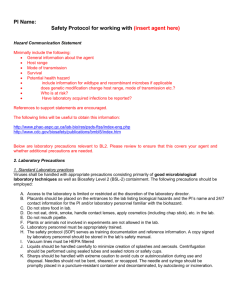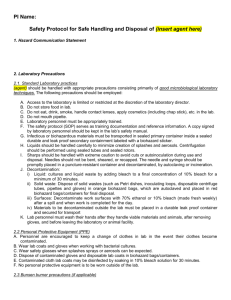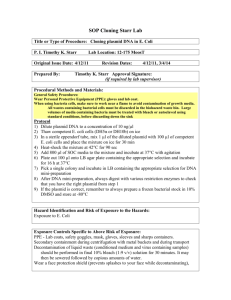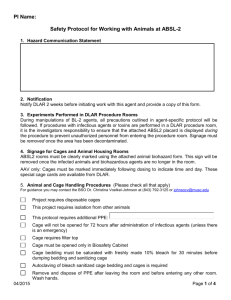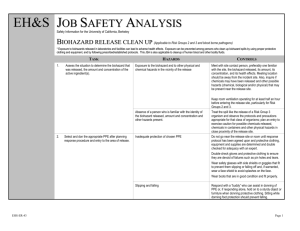Lenti/Retro-viral vector
advertisement
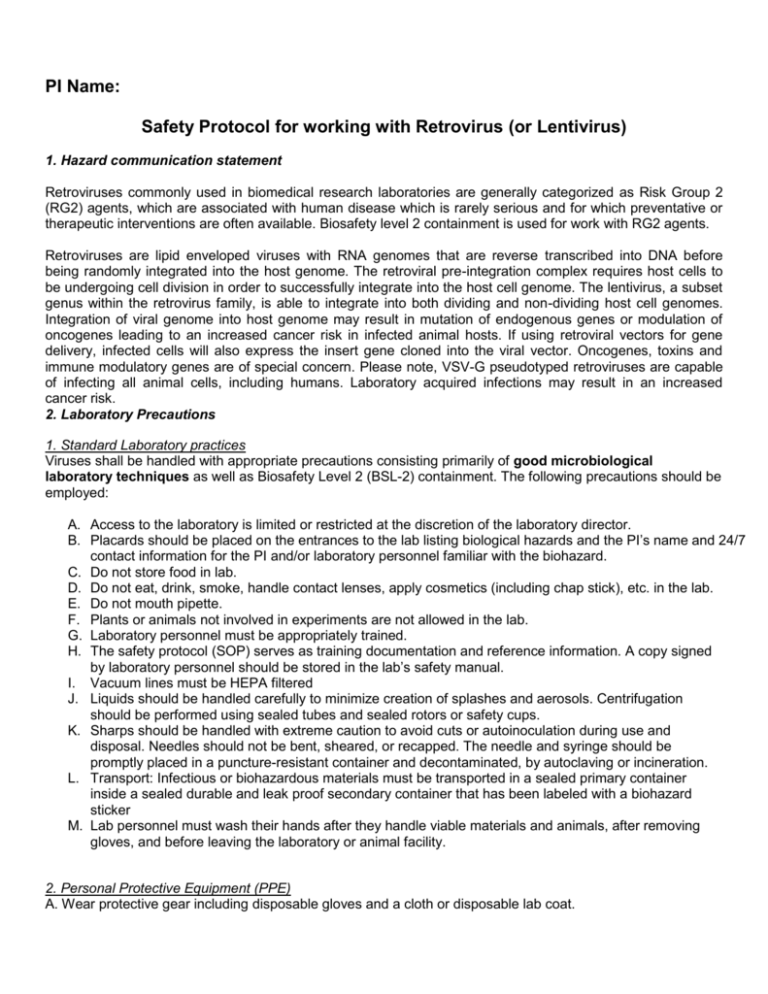
PI Name: Safety Protocol for working with Retrovirus (or Lentivirus) 1. Hazard communication statement Retroviruses commonly used in biomedical research laboratories are generally categorized as Risk Group 2 (RG2) agents, which are associated with human disease which is rarely serious and for which preventative or therapeutic interventions are often available. Biosafety level 2 containment is used for work with RG2 agents. Retroviruses are lipid enveloped viruses with RNA genomes that are reverse transcribed into DNA before being randomly integrated into the host genome. The retroviral pre-integration complex requires host cells to be undergoing cell division in order to successfully integrate into the host cell genome. The lentivirus, a subset genus within the retrovirus family, is able to integrate into both dividing and non-dividing host cell genomes. Integration of viral genome into host genome may result in mutation of endogenous genes or modulation of oncogenes leading to an increased cancer risk in infected animal hosts. If using retroviral vectors for gene delivery, infected cells will also express the insert gene cloned into the viral vector. Oncogenes, toxins and immune modulatory genes are of special concern. Please note, VSV-G pseudotyped retroviruses are capable of infecting all animal cells, including humans. Laboratory acquired infections may result in an increased cancer risk. 2. Laboratory Precautions 1. Standard Laboratory practices Viruses shall be handled with appropriate precautions consisting primarily of good microbiological laboratory techniques as well as Biosafety Level 2 (BSL-2) containment. The following precautions should be employed: A. Access to the laboratory is limited or restricted at the discretion of the laboratory director. B. Placards should be placed on the entrances to the lab listing biological hazards and the PI’s name and 24/7 contact information for the PI and/or laboratory personnel familiar with the biohazard. C. Do not store food in lab. D. Do not eat, drink, smoke, handle contact lenses, apply cosmetics (including chap stick), etc. in the lab. E. Do not mouth pipette. F. Plants or animals not involved in experiments are not allowed in the lab. G. Laboratory personnel must be appropriately trained. H. The safety protocol (SOP) serves as training documentation and reference information. A copy signed by laboratory personnel should be stored in the lab’s safety manual. I. Vacuum lines must be HEPA filtered J. Liquids should be handled carefully to minimize creation of splashes and aerosols. Centrifugation should be performed using sealed tubes and sealed rotors or safety cups. K. Sharps should be handled with extreme caution to avoid cuts or autoinoculation during use and disposal. Needles should not be bent, sheared, or recapped. The needle and syringe should be promptly placed in a puncture-resistant container and decontaminated, by autoclaving or incineration. L. Transport: Infectious or biohazardous materials must be transported in a sealed primary container inside a sealed durable and leak proof secondary container that has been labeled with a biohazard sticker M. Lab personnel must wash their hands after they handle viable materials and animals, after removing gloves, and before leaving the laboratory or animal facility. 2. Personal Protective Equipment (PPE) A. Wear protective gear including disposable gloves and a cloth or disposable lab coat. o If using a cloth lab coat, it must remain in the cell culture room, virus procedure room or inside a biohazard bag in the lab. B. Wear safety glasses and face protection when splashes, sprays or aerosols can be expected. C. Dispose of contaminated PPE in biohazard bags/containers. D. No personal protective equipment shall be worn outside of the lab. 3. Working Procedures for Viral Vectors Before working with virus: prepare a solution of 10% bleach in water in appropriate containers for disinfecting supplies that may come in contact with the virus. This solution should at minimum be prepared fresh weekly. put on PPE While working with virus: always use aseptic technique avoid the spread of contamination and immediately replace gloves, if contamination is suspected. After working with virus: If applicable, vacuum lines will be rinsed with 10% bleach. Treat liquid waste with bleach to a final concentration of 10% bleach for a minimum contact time of 30 minutes. After 30 minutes, dispose of liquid waste in a sink with copious amounts of running water. Solid waste including pipettes, containers, etc. that come in contact with virus must be disinfected with 10% bleach prior to disposal in biohazard waste container. Autoclave biohazard waste upon completion. Dispose of solid wastes in in orange bags, which are autoclaved and placed in a red biohazard bag/container for final disposal. Following disposal of the liquid waste, rinse glassware with 10% bleach, followed by washing and autoclaving. Disinfect work surfaces with 10% bleach. Bleach can corrode metal surfaces, but this can be avoided by wiping the surface with water or 70% ethanol after decontaminating to remove the bleach. Remove disposable PPE and dispose of it in biohazard bags. Wash hands with soap and water. 3. Emergency procedures 3A. Spills of virus: 1) Notify workers in the area. 2) Leave the area for 15 minutes to allow aerosols to settle. Replace contaminated PPE. 3) Upon return, mix spill with freshly made bleach to 10% final concentration. 4) Allow 30 minutes of contact time for disinfection. 5) Absorb spill with paper towels and dispose them into biohazard bags. 6) Use dustpan and broom to sweep up debris. Broken glass must be deposited into broken glass or sharps box. 7) Wipe the spill area clean using 10% bleach. 8) Dispose of contaminated PPE in autoclavable biohazard bags. 3B. In the event of injury or exposure 1) CLEANSE WOUND: Wash all wounds immediately with antiseptic soap and a high volume of water for up to 15 minutes. 2) CONTROL BLEEDING: Apply bandage and firmly press to control bleeding. 3) ACCIDENTAL INGESTION: Rinse mouth with water but do not swallow. 4) SEEK IMMEDIATE MEDICAL FOLLOW-UP (do not wait 24 hrs) Employees and students go to: Employee Health Services (during business hours: Monday-Friday, 7:30 am -4 pm). Address/Location: 57 Bee Street, Charleston SC 29425; Phone: (843) 792-2991 MUSC Emergency Room (after business hours) Address/Location: 96 Jonathan Lucas Street, Charleston SC 29425 Be prepared to discuss the nature of the virus and risks of rDNA with the physician. For retroor lentiviral vectors also discuss possible intervention with anti-retroviral therapy to mitigate the risk associated with infection. 5) REPORT EXPOSURE IMMEDIATELY to your supervisor or Principal Investigator and notify Biosafety Officer (843-792-3604). 6) NOTIFY Employee Health Services within 24 hours by filing an ACORD First Report of Injury form at https://www.carc.musc.edu/acord/ A. If cloth lab coats were worn, they should be removed, treated with 10% bleach for 30 minutes and placed in biohazard bags to be autoclaved. B. Spills of virus: Notify workers in the area. Leave the area for 15 minutes to allow aerosols to settle or be removed by the room’s air changes. Replace contaminated PPE. Place paper towels over the spill and treat with bleach to obtain a minimum concentration of 10% final concentration. Allow 30 minutes of contact time for disinfection. Place paper towels in biohazard bags. Use forceps or a dustpan and broom to pick up broken glass from dropped glassware. Wipe the spill area clean using 10% bleach. Dispose of contaminated PPE in autoclavable biohazard bags. If cloth lab coats were worn, they should be removed, treated with 10% bleach for 30 minutes and placed in biohazard bags to be autoclaved. C. In the event of injury or exposure (including animals bites), carefully and thoroughly wash the injured or exposed area with clean water for up to 15 minutes. Immediately notify the Principal Investigator and the Biosafety Officer (843-792-3604) about the nature of the incident. Proceed to employee/student health or the ER if after hours. Be prepared to discuss the nature of the virus and risks of rDNA with the physician. For retro- or lentiviral vectors also discuss possible intervention with anti-retroviral therapy to mitigate the risk associated with infection. In addition report injuries and exposures to Employee Health Services by submitting an ACORD form via the following site: http://mcintranet.musc.edu/ehs/work_related.htm By signing below I attest that I have read and understood these safety instructions and agree to adhere to these rules at all times. Furthermore, I feel I have been properly notified and trained of the hazards in this laboratory. Name (print) Signature _____________________________ ______________________________ Date: ___________ _____________________________ ______________________________ Date: ___________ _____________________________ ______________________________ Date: ___________ _____________________________ ______________________________ Date: ___________ _____________________________ ______________________________ Date: ___________ _____________________________ ______________________________ Date: ___________ _____________________________ ______________________________ Date: ___________
